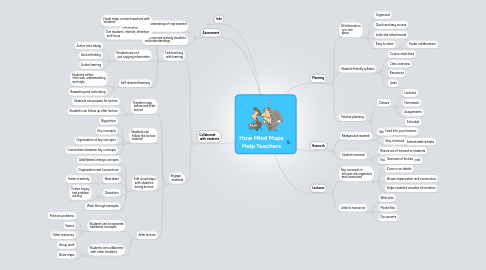
1. Info
1.1. Toni Krasnic, author of Concise Learning
1.1.1. wwww.ConciseLearning.com
1.1.2. Teaching with mind maps
1.2. Cartoons by Ron Leishman
1.2.1. www.toonclipart.com
1.2.2. www.toonaday.com
2. Assessment
2.1. Detect students' understandings of represented information
2.2. Diagnose and remedy students' misunderstandings
3. Collaborate with students
3.1. Link teaching with learning
3.1.1. Visual maps connect teachers with students
3.1.2. Get students' interest, attention, and focus
3.1.3. Students are not just copying information
3.1.3.1. Active note taking
3.1.3.2. Active thinking
3.1.3.3. Active learning
3.1.4. Self-directed learning
3.1.4.1. Students reflect their own understanding and style
3.1.4.2. Rewarding and motivating
3.2. Engage students
3.2.1. Transfer maps before and after lecture
3.2.1.1. Students can prepare for lecture
3.2.1.2. Students can follow up after lecture
3.2.2. Students can follow the lecture material
3.2.2.1. Big picture
3.2.2.2. Key concepts
3.2.2.3. Organization of key concepts
3.2.2.4. Connections between key concepts
3.2.3. Edit visual maps with students during lecture
3.2.3.1. Add/delete/change concepts
3.2.3.2. Organization and connections
3.2.3.3. New ideas
3.2.3.3.1. Foster creativity
3.2.3.4. Questions
3.2.3.4.1. Foster inquiry and problem solving
3.2.3.5. Work through examples
3.2.4. After lecture
3.2.4.1. Students can incorporate additional concepts
3.2.4.1.1. Practice problems
3.2.4.1.2. Exams
3.2.4.1.3. Other resources
3.2.4.2. Students can collaborate with other students
3.2.4.2.1. Group work
3.2.4.2.2. Share maps
4. Planning
4.1. All information is in one place
4.1.1. Organized
4.1.2. Quick and easy access
4.1.3. Links and attachments
4.1.4. Easy to share
4.1.4.1. Foster collaboration
4.2. Student-friendly syllabus
4.2.1. Course objectives
4.2.2. Class overview
4.2.3. Resources
4.2.4. Links
4.3. Teacher planning
4.3.1. Classes
4.3.1.1. Lectures
4.3.1.2. Homework
4.3.1.3. Assignments
4.3.2. Semester
4.3.2.1. Schedule
4.3.2.2. To do's
4.3.2.3. Administrative tasks
5. Research
5.1. Background research
5.1.1. Feed into your lectures
5.1.2. Stay informed
5.2. Student research
5.2.1. Resources of interest to students
5.2.2. Easily organized and assigned
6. Lectures
6.1. Key concepts in lectures are organized and connected
6.1.1. Overview of lecture
6.1.2. Zoom in on details
6.1.3. Shows organization and connections
6.1.4. Helps students visualize information
6.2. Links to resources
6.2.1. Web sites
6.2.2. Media files
6.2.3. Documents
